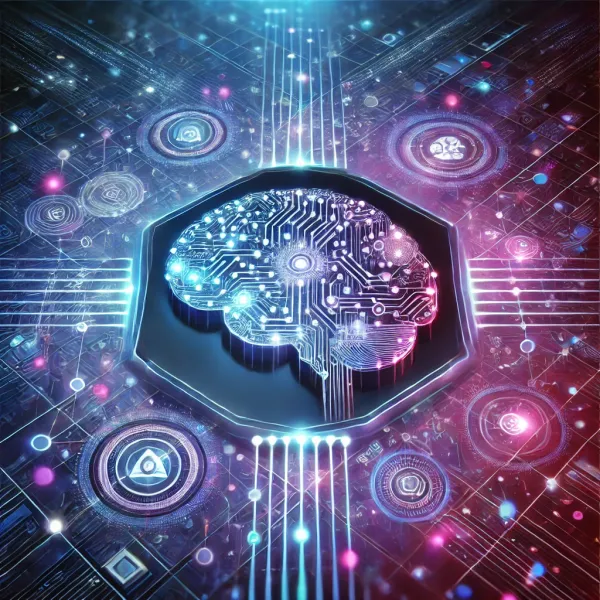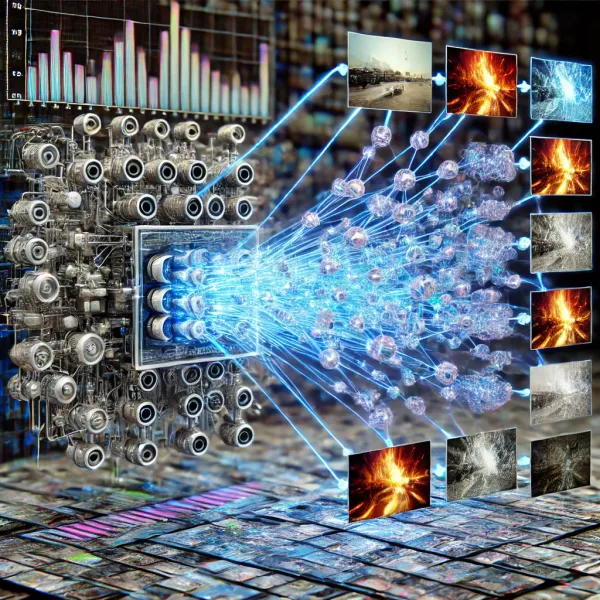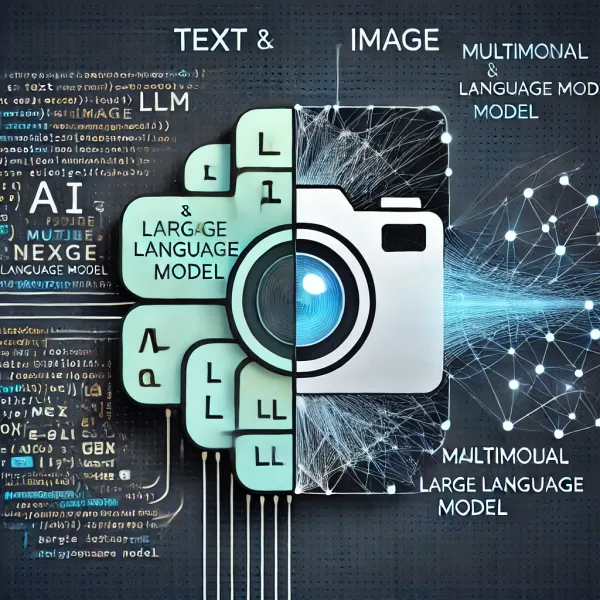Unveiling the Magic: How Multimodal Large Language Models Work
Dive into the fascinating world of multimodal Large Language Models (LLMs) and discover how these AI marvels process text, images, video, and audio. This comprehensive guide explores the architecture, training process, applications, and ethical considerations of these powerful AI systems.

Introduction
In the rapidly evolving landscape of artificial intelligence, multimodal Large Language Models (LLMs) have emerged as a revolutionary force, capable of processing and understanding various forms of data including text, images, video, and audio. These advanced AI models are pushing the boundaries of what's possible in natural language processing and computer vision, opening up new possibilities for human-computer interaction and data analysis.
But how exactly do these sophisticated systems work? In this comprehensive guide, we'll dive deep into the inner workings of multimodal LLMs, exploring their architecture, training process, and the unique challenges they face. Whether you're a seasoned AI practitioner or a curious newcomer, this post will help you understand the magic behind these powerful models.
Understanding Multimodal LLMs
What are Multimodal LLMs?
Multimodal Large Language Models are AI systems designed to process and understand multiple types of data inputs, including:
- Text
- Images
- Video
- Audio
Unlike traditional LLMs that focus solely on text, multimodal models can interpret and generate content across various modalities, making them more versatile and capable of handling complex real-world scenarios.
The Evolution from Text-Only to Multimodal Models
The journey from text-only LLMs to multimodal models has been a significant leap in AI development. Early LLMs like GPT (Generative Pre-trained Transformer) series focused exclusively on text processing. However, as researchers recognized the need for AI to understand the world more holistically, efforts were made to incorporate other modalities.
This evolution was driven by the realization that human communication and understanding are inherently multimodal. We don't just rely on text to communicate; we use gestures, facial expressions, images, and sounds to convey meaning. By developing AI models that can process multiple modalities, we're moving closer to creating systems that can interact with the world in a more human-like manner.
Architecture of Multimodal LLMs
The Transformer Architecture: The Foundation
At the core of most multimodal LLMs lies the Transformer architecture, originally introduced in the paper "Attention Is All You Need" by Vaswani et al. The Transformer's self-attention mechanism allows the model to weigh the importance of different parts of the input when processing each element, making it highly effective for handling sequential data like text.
Extending Transformers for Multimodal Input
To handle multiple modalities, the basic Transformer architecture is extended in several ways:
- Modality-Specific Encoders: Each modality (text, image, video, audio) has its own specialized encoder that converts the raw input into a format the model can process.
- Unified Representation Space: The outputs from different modality encoders are projected into a shared embedding space, allowing the model to process all modalities together.
- Cross-Modal Attention: This mechanism allows the model to attend to information across different modalities, enabling it to make connections between, for example, text and related images.
- Modality Fusion: Various techniques are employed to combine information from different modalities, such as early fusion, late fusion, or adaptive fusion.
See Understanding Multimodal Large Language Models: Feature Extraction and Modality-Specific Encoders
Example: Vision-Language Models
Let's take a closer look at how a vision-language model (a type of multimodal LLM that processes both text and images) might work:
- Image Encoding: The image is processed through a convolutional neural network (CNN) or a Vision Transformer (ViT) to extract visual features.
- Text Encoding: The text is tokenized and processed through a text encoder, typically based on the Transformer architecture.
- Feature Alignment: The visual and textual features are projected into a common embedding space.
- Cross-Modal Processing: The aligned features are processed together using self-attention mechanisms that can attend to both visual and textual elements.
- Output Generation: The model generates output based on the task, which could be image captioning, visual question answering, or text-to-image generation.
Training Multimodal LLMs
Data Collection and Preprocessing
Training multimodal LLMs requires vast amounts of diverse, high-quality data across all supported modalities. This typically involves:
- Text Data: Web pages, books, articles, and social media content.
- Image Data: Photographs, diagrams, artworks, and screenshots.
- Video Data: Movie clips, TV shows, user-generated content, and educational videos.
- Audio Data: Speech recordings, music, ambient sounds, and sound effects.
Each type of data requires specific preprocessing steps:
- Text data is typically tokenized and normalized.
- Images are resized, normalized, and augmented.
- Videos are often broken down into frame sequences and may undergo similar processing as images.
- Audio data is converted into spectrograms or other representations that can be processed by neural networks.
Training Objectives
Multimodal LLMs are typically trained using a combination of objectives:
- Masked Language Modeling: Predicting masked words in text, similar to BERT.
- Image-Text Matching: Determining whether a given image matches a given text description.
- Visual Question Answering: Generating text answers to questions about images.
- Image Captioning: Generating text descriptions of images.
- Audio-Text Alignment: Matching audio segments to corresponding text transcriptions.
- Cross-Modal Generation: Generating content in one modality based on input from another (e.g., text-to-image generation).
Training Process
The training process for multimodal LLMs is computationally intensive and often involves the following steps:
- Pre-training: The model is trained on a large corpus of multimodal data to learn general representations.
- Fine-tuning: The pre-trained model is further trained on task-specific datasets to adapt it for particular applications.
- Continual Learning: Some models are designed to continuously learn and update their knowledge over time.
- Multi-task Learning: Training the model on multiple tasks simultaneously to improve its generalization abilities.
Challenges in Training Multimodal LLMs
Training these complex models comes with several challenges:
- Data Quality and Bias: Ensuring the training data is diverse, representative, and free from harmful biases.
- Computational Resources: The immense size of these models requires significant computational power for training.
- Modality Alignment: Ensuring that information from different modalities is properly aligned and integrated.
- Catastrophic Forgetting: Preventing the model from forgetting previously learned information when learning new tasks.
- Evaluation Metrics: Developing appropriate metrics to evaluate performance across different modalities and tasks.
Applications of Multimodal LLMs
The versatility of multimodal LLMs has led to their adoption in various fields:
- Healthcare: Analyzing medical images alongside patient records for improved diagnosis.
- Education: Creating interactive learning experiences that combine text, images, and videos.
- E-commerce: Enhancing product search and recommendations by understanding both text descriptions and product images.
- Robotics: Enabling robots to understand and interact with their environment through multiple sensory inputs.
- Content Creation: Assisting in the creation of multimedia content, from writing articles to generating images and videos.
- Accessibility: Improving assistive technologies for people with disabilities by translating between different modalities (e.g., text-to-speech, image-to-text).
Ethical Considerations and Challenges
As with any powerful AI technology, multimodal LLMs raise important ethical considerations:
- Privacy Concerns: These models can potentially identify individuals in images or videos, raising privacy issues.
- Misinformation: The ability to generate realistic text, images, and videos could be misused to create convincing fake content.
- Bias and Fairness: Ensuring that the models don't perpetuate or amplify societal biases present in their training data.
- Environmental Impact: The substantial computational resources required for training these models have significant environmental implications.
- Transparency and Explainability: As these models become more complex, ensuring their decision-making processes are interpretable becomes increasingly challenging.
Future Directions
The field of multimodal LLMs is rapidly evolving. Some exciting future directions include:
- Improved Cross-Modal Understanding: Enhancing the models' ability to make connections across different modalities.
- More Efficient Architectures: Developing model architectures that can process multiple modalities more efficiently.
- Expansion to New Modalities: Incorporating additional sensory inputs like touch or smell.
- Real-time Processing: Enabling multimodal LLMs to process and respond to inputs in real-time for interactive applications.
- Personalization: Creating models that can adapt to individual users' preferences and needs across different modalities.
Conclusion
Multimodal Large Language Models represent a significant leap forward in AI technology, bringing us closer to creating machines that can understand and interact with the world in ways similar to humans. By processing and integrating information from text, images, video, and audio, these models are opening up new possibilities in fields ranging from healthcare to education to creative arts.
As we continue to push the boundaries of what's possible with multimodal AI, it's crucial to approach this technology with a balance of excitement and responsibility. By addressing the ethical challenges and focusing on developing these models in ways that benefit humanity, we can harness the full potential of multimodal LLMs to create a more intelligent, accessible, and interconnected world.
The journey of multimodal AI is just beginning, and the future holds endless possibilities. Whether you're a developer, researcher, or simply an AI enthusiast, staying informed about these advancements will be key to understanding and shaping the future of artificial intelligence.




